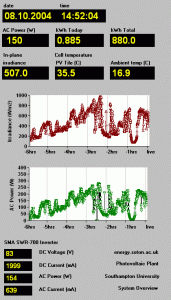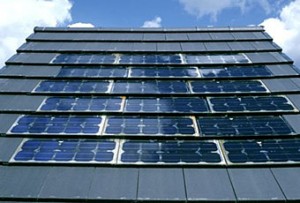Capital cost is the major issue and this impacts most directly on the size of a PV roof tile. For the ‘best integration’ a PV roof tile should be indentical in size and weight to a normal concrete tile. For example, a Marley Modern tile would provide an exposed area of 292 x 345 mm available for use with PV, which corresponds to a custom PV module of ~10 Wp using current terrestrial mono-crystalline silicon wafer technology. This size is too small to make the manufacture of custom laminates economic.
Most PV roof tile designs are based on a ratio of between 2.5 and 4X of the cover width of the concrete tile with which they integrate. Increasing the width improves the economics significantly both in terms of capital and installation cost. However, as the size increases the product becomes less like a tile in terms of its behaviour and more susceptible to the quality of the roof construction.
SERG has developed a PV roof tile through Powertile Ltd which is now sold under license by Marley Eternit. A test roof at the University, which is shown in Figure 3, is used for prototype assessment and analysis of the thermal behaviour of different roof constructions.
The Powertile tile is unique in the marketplace in that it is a two part construction which divorces the (1) active upper PV element from a (2) lower supporting base. This approach enables a faulty tile to be serviced in-situ without disturbing the surrounding roof. This is demonstrated in Figure 4. The upper component is simply released using ¼ turn fasteners and slides on runners into a service position. When a tile has been repaired or exchanged the tile is simply pushed back into position and it automatically mates electrically as it is mechanically locked into position.
Programme Outline
1) To install a small array of Powertile photovoltaic roof tiles on the Eustice test-roof with associated propriety concrete tiles and ridge and eave components.
2) To monitor the temperature, humidity distribution, power performance of the tiles and the array system under conditions of high and low irradiance.
3) Produce analysis showing stack effect development in temperature on the underside of the tiles up the roof. Correlate ambient temperature and irradiance to the temperature of the tiles within a roof system.
4) Vary the air inlet (eaves) and outlet (ridges) sizes to determine effect on stack effect and roof temperature. Determine the effect of the above tests on power output from tiles.
5) Repeat (2), (3) and (4) for a double battened roof system. Determine the change in stack effect the double width air gap produces.
6) Thermal simulation of systems (2), (3), (4) and (5) using computer modelling to enable prediction of temperature behaviour in larger roof systems.
 Live Monitoring – PV Roof Tile System
Live Monitoring – PV Roof Tile System
A live monitoring of the roof tile system is available on the group’s website. The previous six hours of operation are shown graphically. Additionally the number of kWh generated each day is shown.
The system has one inverter (SMA 700) which gives the AC Power (Pac) of the system. Each tile uses 10 BP Saturn cells giving a tile output of 23 Wp under standard test conditions (1000 W/m2 irradiance, 25°C cell temperature). The maximum power point voltage of the string is approximately 80 V (at 50°C cell temperature).
The DC voltage (DC V) and current (DC I) supplying the inverter is also shown.
The In-plane irradiance is a measure of the intensity of the sunlight reaching the roof. 1000 W/m2 represents ideal, very bright conditions. Less than 200 W/m2 is fairly overcast. Less than 100 W/m2 is very cloudy.
The solar tile assembly has been patented and is published by the World Intellectual Property Organization (WIPO) under the publication number WO/2000/077860 – SOLAR TILE ASSEMBLY.

